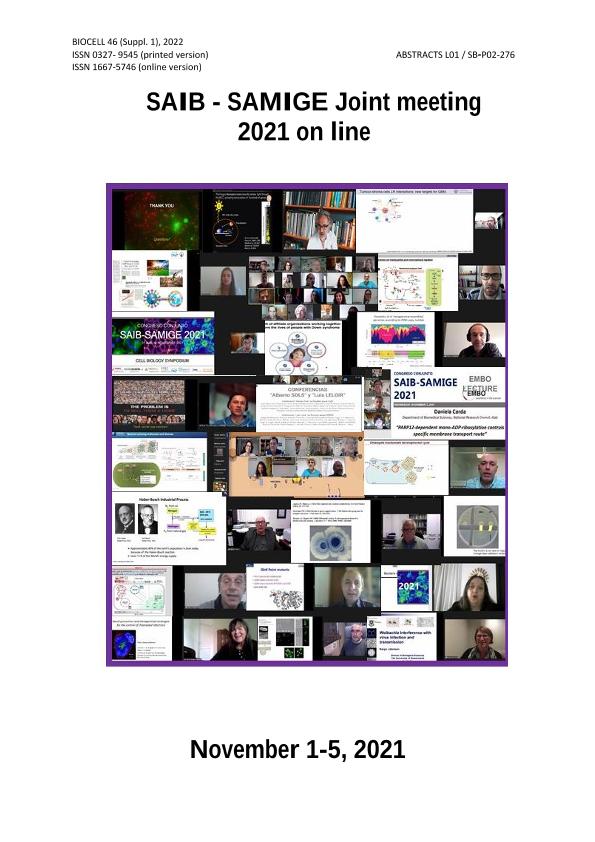Mostrar el registro sencillo del ítem
dc.contributor.author
Hernández, Martín Alejandro

dc.contributor.author
Ledesma, A.
dc.contributor.author
Alvarez, Hector Manuel

dc.date.available
2022-02-23T11:52:08Z
dc.date.issued
2022
dc.identifier.citation
Contribution of a specific XRE family transcriptional regulator to the oleaginous phenotype in rhodococci; LVII Annual Meeting of the Argentine Society for Biochemistry and Molecular Biology Research and XVI Annual Meeting of the Argentinean Society for General Microbiology; Argentina; 2021; 1-3
dc.identifier.issn
0327-9545
dc.identifier.uri
http://hdl.handle.net/11336/152576
dc.description.abstract
Oleagenicity is a property attributed to some microorganisms capable of accumulating high levels of intracellular lipids within the so-called lipid droplets (LDs). Some species of the Rhodococcus genus, such as R. opacus and R. jostii, are able to accumulate triacylglycerols (TAG) up to 60% or more of their cellular dry weight. For this reason, oleaginous rhodococci are promising microbial cell factories for the production of lipids to be used as fuels and oleochemicals. Although several genes involved in TAG biosynthesis and accumulation have been well described, it is not clear yet how these processes are regulated. Global and specific transcriptional regulators (TRs) contribute to the oleaginous phenotype in Rhodococcus. Among specific TRs, a XRE family transcriptional regulator (TR) is associated with the lipid droplet ontogeny through regulation of a structural protein coding gene. In this work, we study the role of this specific TR on lipid metabolism in oleaginous rhodococci at the physiological and molecular level. Bioinformatic analysis revealed the occurrence of this regulator only in actinobacteria. In addition, the occurrence of putative TR boxes into the promoters regions varied between oleaginous Rhodococcus strains and non-oleaginous strains. Docking studies revealed putative interactions of this specific TR with palmitic acid. In vitro and in vivo assays confirmed that the TR binding capacity to DNA is controlled by long chain fatty acids or their acyl-CoA derivatives. Glutaraldehyde (GT) cross-linker assay and limited proteolysis analysis revealed that long chain fatty acids induce oligomerization and conformational changes of TR, respectively. Furthermore, putative binding sites for this TR within upstream regions of genes coding for a lipase, an acyl-CoA dehydrogenase and the fatty acid synthase complex (FASI) were found and validated by EMSA and RT-PCR assays. Finally, deregulation of the TR levels by overexpression of the corresponding gene was used as a strategy to improved TAG biosynthesis and lipid recovery for biotechnological purposes under rich nitrogen conditions. We propose a model in which the activity of this TR is controlled by fatty acyl-CoA pools in cells according to the nutritional conditions of the environment. In addition, this protein participates in the regulatory network controlling lipid metabolism and lipid droplet formation in oleaginous rhodococci.
dc.format
application/pdf
dc.language.iso
eng
dc.publisher
Tech Science Press

dc.rights
info:eu-repo/semantics/openAccess
dc.rights.uri
https://creativecommons.org/licenses/by-nc-sa/2.5/ar/
dc.subject
RHODOCOCCUS
dc.subject
REGULATION
dc.subject
LIPIDS
dc.subject.classification
Biología Celular, Microbiología

dc.subject.classification
Ciencias Biológicas

dc.subject.classification
CIENCIAS NATURALES Y EXACTAS

dc.title
Contribution of a specific XRE family transcriptional regulator to the oleaginous phenotype in rhodococci
dc.type
info:eu-repo/semantics/publishedVersion
dc.type
info:eu-repo/semantics/conferenceObject
dc.type
info:ar-repo/semantics/documento de conferencia
dc.date.updated
2022-02-17T13:22:32Z
dc.identifier.eissn
1667-5746
dc.journal.number
46
dc.journal.pagination
1-3
dc.journal.pais
Estados Unidos

dc.description.fil
Fil: Hernández, Martín Alejandro. Universidad Nacional de la Patagonia "San Juan Bosco". Instituto de Biociencias de la Patagonia. Consejo Nacional de Investigaciones Científicas y Técnicas. Centro Científico Tecnológico Conicet - Centro Nacional Patagónico. Instituto de Biociencias de la Patagonia; Argentina
dc.description.fil
Fil: Ledesma, A.. Consejo Nacional de Investigaciones Científicas y Técnicas. Centro Científico Tecnológico Conicet Noa Sur. Centro de Investigación en Biofísica Aplicada y Alimentos. - Universidad Nacional de Santiago del Estero. Centro de Investigación en Biofísica Aplicada y Alimentos; Argentina
dc.description.fil
Fil: Alvarez, Hector Manuel. Universidad Nacional de la Patagonia "San Juan Bosco". Instituto de Biociencias de la Patagonia. Consejo Nacional de Investigaciones Científicas y Técnicas. Centro Científico Tecnológico Conicet - Centro Nacional Patagónico. Instituto de Biociencias de la Patagonia; Argentina
dc.relation.alternativeid
info:eu-repo/semantics/altIdentifier/url/https://www.techscience.com/biocell/v46nSuppl.1
dc.conicet.rol
Autor

dc.conicet.rol
Autor

dc.conicet.rol
Autor

dc.coverage
Internacional
dc.type.subtype
Reunión
dc.description.nombreEvento
LVII Annual Meeting of the Argentine Society for Biochemistry and Molecular Biology Research and XVI Annual Meeting of the Argentinean Society for General Microbiology
dc.date.evento
2021-11-01
dc.description.paisEvento
Argentina

dc.type.publicacion
Journal
dc.description.institucionOrganizadora
Sociedad Argentina de Investigación en Bioquímica y Biología Molecular
dc.description.institucionOrganizadora
Asociación Civil de Microbiología General
dc.source.revista
Biocell

dc.date.eventoHasta
2021-11-05
dc.type
Reunión
Archivos asociados
